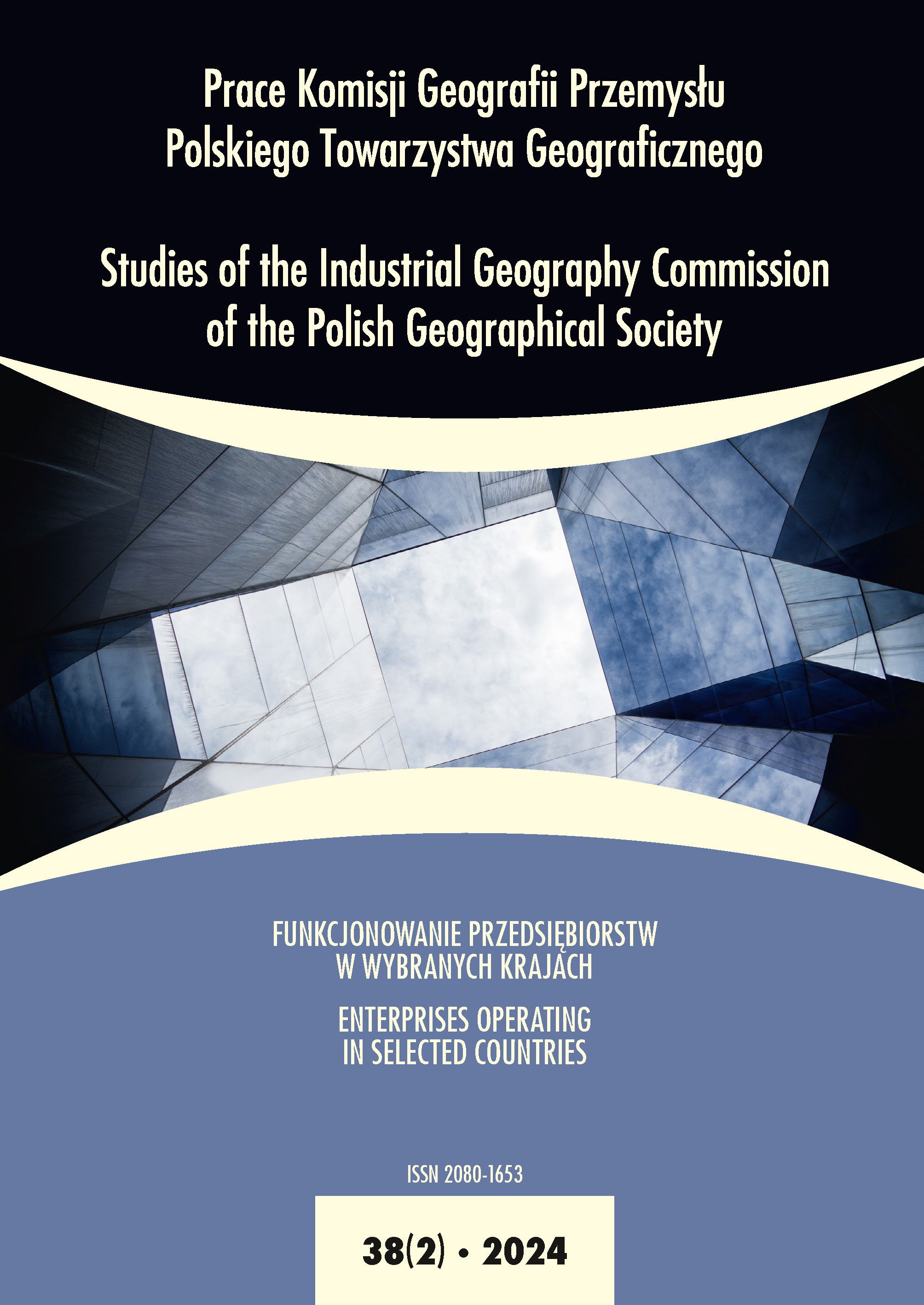Differentiation and dynamics of industrial activity in Poland from 2005 to 2020
DOI:
https://doi.org/10.24917/20801653.382.2Keywords:
innovation, economic crisis, industry, industrial development, industry structure, innovation industryAbstract
The development of a country’s economy is linked to the industrial development of its territory, which affects its pattern. In addition, contemporary economic challenges, especially in the context of crises, emphasize the importance of analyzing the both the pattern and dynamics of industry in Poland in relation to its regional differentiation. The purpose of the research is to evaluate changes in the development of industry in the years 2005–2020, while taking into account the impact of the COVID-19 pandemic. The period adopted for the research covers the time of the economic crisis which allowed significant changes and trends in industrial activity to be identified at the level of NUTS 2 regions. An analysis of six selected industrial sectors was carried out due to their key importance in Polish industry at the end of the 20th and in the first decades of the 21st century. The research used quantitative methods, based on data obtained primarily from the Local Data Bank of the Central Statistical Office (CSO) and Eurostat, and presents data related to employment, the number of enterprises and diversification of industry. The research carried out showed an increasing role in Poland’s economic development played by those provinces that have a historically strong position, i.e. Silesia, Mazovia and Wielkopolska. The study concluded that the economic crisis, especially as related to the COVID-19 pandemic, had a limited impact on the spatial differentiation of industry in Poland. It was noted that the changes tended to follow previous trends. Therefore, it can be assumed that the consequences of the COVID-19 economic crisis, and in the following years instabilities in global markets, will have their impact in the longer term.
Downloads
Metrics
References
Balicki, M. (2014). Bezpośrednie inwestycje zagraniczne w kształtowaniu innowacyjnych obszarów województwa podkarpackiego. Świat Nieruchomości, 87, 59–67.
Bank Danych Lokalnych GUS. (2024). Pozyskano z: https://bdl.stat.gov.pl/bdl/start (dostęp: 20.02.2024).
Baruk, J. (2004). Charakterystyka działalności badawczo -rozwojowej. Problemy Zarządzania, 1(3), 32–52.
Brezdeń, P. (2023). Działalność przemysłowa i jej struktura przestrzenna w czasie trwania pandemii COVID-19 w Polsce. Prace Komisji Geografii Przemysłu Polskiego Towarzystwa Geograficznego, 37(2), 7–24.
Brezdeń, P. (2022). Działalność przemysłowa w Polsce i zmiana jej struktury przestrzennej w czasie pandemii SARS -CoV-2. Prace Komisji Geografii Przemysłu Polskiego Towarzystwa Geograficznego, 36(2), 47–65.
Brezdeń, P. (2019). Procesy koncentracji i specjalizacji przemysłu w województwie dolnośląskim w latach 2005–2016 – ujęcie przestrzenne. Prace Komisji Geografii Przemysłu Polskiego Towarzystwa Geograficznego, 33(4), 42–62.
Brezdeń, P., Spallek, W. (2013). Przestrzenne zróżnicowanie poziomu innowacyjności regionalnej gospodarki województwa dolnośląskiego. Prace Komisji Geografii Przemysłu Polskiego Towarzystwa Geograficznego, 23, 9–25.
Brezdeń, P., Szmytkie, R. (2017). Procesy koncentracji działalności przemysłowej w strefie podmiejskiej na przykładzie Dolnego Śląska. Prace Komisji Geografii Przemysłu Polskiego Towarzystwa Geograficznego, 31(2), 56–74.
Borowska -Stefańska, M., Wiśniewski, S. (2018). Rozmieszczenie i zróżnicowanie przestrzenne terenów przemysłowych w województwie mazowieckim na tle rozmieszczenia i zróżnicowania przestrzennego terenów przemysłowych w Polsce. Mazowsze. Studia Regionalne, 24, 11–30.
Czapliński, P., Rachwał, T., Tobolska, A., Uliszak, R. (2007). Geografia gospodarcza. Przewodnik do ćwiczeń. Bogucki Wydawnictwo Naukowe: Poznań–Kraków.
Domański, B., Dej, M., Działek, J., Gwosdz, K., Sobala-Gwosdz, A. (2011). Znaczenie przemysłu dla „inteligentnego i trwałego” rozwoju regionu Polski Wschodniej oraz podejmowanych działań dotyczących jego restrukturyzacji i modernizacji. Warszawa: Ekspertyza przygotowana na zlecenie Departamentu Programów Ponadregionalnych Ministerstwa Rozwoju Regionalnego.
Firlej, K. (2017). Przemysł spożywczy w Polsce: Nowa ścieżka rozwoju. Wydawnictwo Naukowe PWN.
Gierańczyk W., Stańczyk, A. (2001). Okręgi przemysłowe w Polsce u progu XXI wieku. Prace Komisji Geografii Przemysłu Polskiego Towarzystwa Geograficznego, 3, 61–69.
Gust -Bardon, M.J. (2011). Nierówności społeczne a wzrost gospodarczy. Innowacyjność w aspekcie regionalnym, 23, 50–63.
Jabłoński, M. (2023). Zróżnicowanie rozwoju przemysłu w Polsce na tle Europy w latach 2000–2020. Praca magisterska, Uniwersytet Komisji Edukacji Narodowej w Krakowie.
Kuna-Marszałek, A., Lisowska, R. (2013). Działalność badawczo -rozwojowa jednostek naukowych i badawczo- rozwojowych w regionie łódzkim. Studia Prawno‑Ekonomiczne, 90, 29–46.
Ostraszewska, Z., Tylec, A. (2016). Nakłady wewnętrzne na działalność badawczo-rozwojową w Polsce i źródła jej finansowania w sektorze przedsiębiorstw. Zeszyty Naukowe Politechniki Częstochowskiej. Zarządzanie, 24.
Piekut, M. (2011). Działalność B+ R czynnikiem rozwoju przedsiębiorstw. Kwartalnik Nauk o Przedsiębiorstwie, 20(3), 87–95.
Rachwał, T., Wiedermann, K., Kilar, W. (2009). Rola przemysłu w gospodarce układów regionalnych Unii Europejskiej. Prace Komisji Geografii Przemysłu Polskiego Towarzystwa Geograficznego, 14, 31–42.
Szum, K., Magruk, A. (2019) Analiza uwarunkowań rozwoju Przemysłu 4.0 w województwie podlaskim. Akademia Zarządzania, 3(2), 73–91.
Downloads
Published
How to Cite
Issue
Section
License
Copyright (c) 2024 Studies of the Industrial Geography Commission of the Polish Geographical Society

This work is licensed under a Creative Commons Attribution-NoDerivatives 4.0 International License.
Articles are published under the terms of the Creative Commons License (CC BY-ND 4.0; Attribution– NoDerivs).

